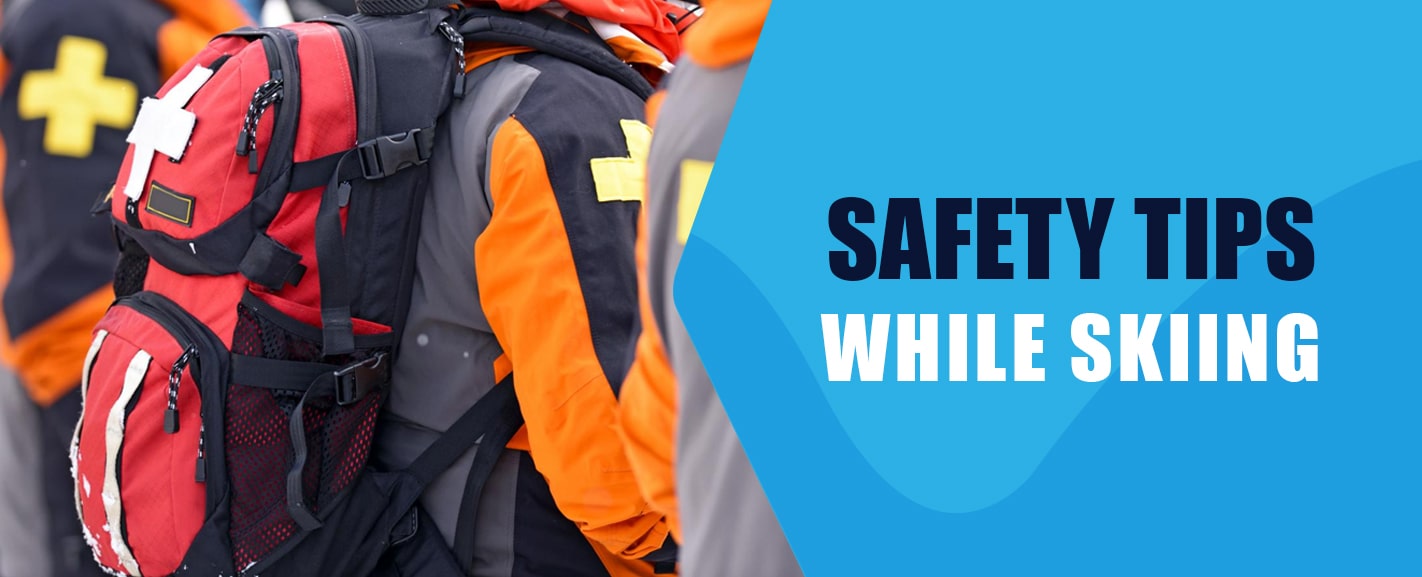 skiing safety tips
skiing safety tips
Safety Tips for Skiing
Posted
by
Matt Gahman
on Monday, November 4, 2019
Skiing is like any sport — there’s always a risk of injury. Skiing involves flying down the side of a mountain at top speed and even going over jumps, all with long rails strapped to your feet. It shouldn’t come as a surprise that sometimes things won’t go your way, and injuries will strike. It’s unfortunate, but it’s the nature of any sport. With the thrill and excitement of the experience comes the risk of injury. It’s a tradeoff we make every time we engage in anything risky.
Still, that’s no reason to leave your health to chance. Some accidents will be unavoidable, but rather than shrugging it off and saying, “I hope today isn’t the day I take a tumble,” we invite you to take an active role in keeping yourself safe on the slopes. How? By practicing good safety etiquette and technique.
You can take several measures to keep yourself safe as you engage in this exciting sport. From wearing the proper gear to learning correct techniques to understanding the rules of the ski resort, all these little pieces add up to keep you and everyone around you a little bit safer. Today, we’ve pulled together this guide to all the top tips for how to stay safe while skiing. Follow these, and your odds of staying safe increase exponentially.
What Is Safe Skiing?
From 2002 to 2012, there was an average of 41.5 fatalities a year at ski resorts. This data shows that skiing has the potential to be highly dangerous and is not something that should be undertaken lightly without any training or safety measures in place.
How can ski injuries be prevented? The good news is that it’s fairly easy. By following a few simple precautions, you can practice safer skiing and keep yourself well away from becoming part of a statistic like this one. Here are our best tips on how to stay safe while skiing.
1. Use the Buddy System
Like most undertakings in life, skiing is always better with a buddy. Skiing with a friend often more fun, but more importantly, it also keeps you both safer. It’s hard to stay safe when skiing alone because, if something happens, there may not always be someone nearby to call for help. If you strike your head, injure your legs, or develop hypothermia, you may not be able to get help yourself, and what might otherwise be a minor incident could quickly turn fatal.
Sticking with a buddy may feel frustrating if one of you wants to rush off to a more advanced spot while the other wants to stick to the easy slopes, but resist the urge to strike out alone. It’s always better to be safe than sorry. We also recommend telling your skiing plans to someone who isn’t coming out on the slopes with you. Tell them where you’re going and when you expect to be back. This way, if something goes wrong and neither of you returns at the appointed time, someone will be able to take action and make sure you’re both all right. If both you and your buddy have had an accident, this backup can be life-saving.
2. Carry a Cell Phone
Always, always, always carry a cell phone with you as you’re heading out onto the mountain or into the snowy wilderness. Even if you’re just going to a ski resort that’s flooded with tourists, we still recommend bringing a way to call for help if need be. If you’re heading very far from civilization and aren’t sure there will be cell coverage, try bringing a satellite phone instead. This way, you can always call to let people know where you are if disaster strikes.
3. Wear Protective Gear
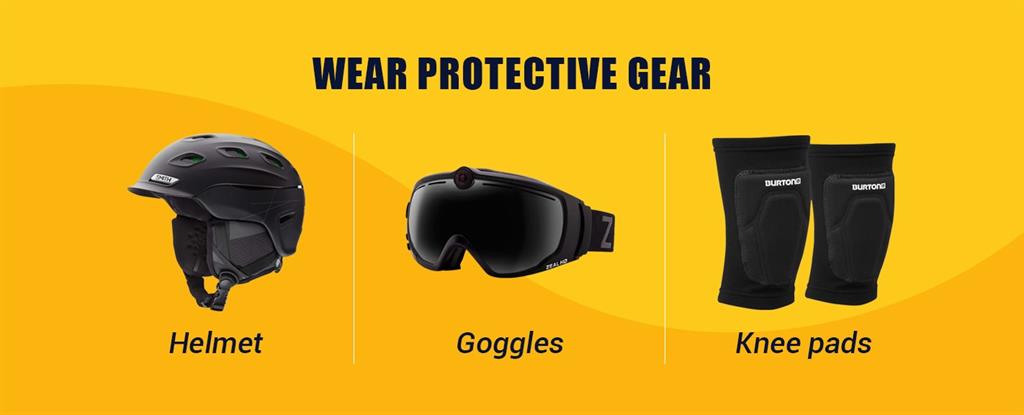
Head injuries account for 20 percent of all skiing injuries. Head injuries also represent the leading cause of death among skiers and snowboarders. It should come as no surprise, then, that adding a skiing helmet to your winter weather ensemble does wonders to reduce your risk of injury. When choosing the perfect helmet, always be sure to try it on to ensure a proper fit. Select a snow helmet that fits snugly on your head without wiggling around, but that isn’t so tight that it causes pain or does not cover your head properly.
As important as it is to protect your head, this isn’t the only part of your body to safeguard. Elbow and knee pads are great ways to protect these often-fragile joints from strains and sprains. Goggles are essential for protecting your eyes from flying pieces of ice and snow, and correctly adjusted and mounted ski bindings keep your boots firmly attached to the ski, helping to prevent injuries when you do take a fall. By adding all these protective pieces to your ensemble, you take the extra step towards ensuring your safety while enjoying this thrilling sport.
4. Use Proper Equipment
Nothing invites a skiing incident faster than old, damaged or inadequate equipment. You may think you’re saving money by using hand-me-down equipment that has seen better days, but we recommend against this. Old equipment can be broken in ways that may not be immediately apparent and that you may not notice until an accident has already occurred. Always use professionally tuned skis that you know the history of, or if you are determined to use old skis and poles, at least get them checked out ahead of time so you can be sure they’re safe to use.
5. Dress for the Weather
It’s easy to get so caught up in worrying about blunt force injuries from falling or crashing into another skier that we forget about the other very real danger you’ll encounter out on the slopes — the cold. The very nature of skiing is such that it demands snow and weather cold enough to support the snow necessary for skiing. This also means dealing with bitterly cold weather while skiing. Hypothermia and even frostbite are both very real possibilities.
The best way to protect yourself from cold-related injury and illness is to dress in layers. Start with a moisture-wicking base layer that will wick away your sweat to keep you dry while also trapping your body heat close to the skin. Add a mid-layer for insulation and then finish off with waterproof snow pants and a snow jacket that will further provide insulation while also keeping the snow and cold well away from your skin. Don’t forget warm socks, gloves, neck warmers and face masks as well to complete your cold-protective ensemble.
6. Learn Proper Technique
Is skiing dangerous for beginners? It absolutely can be. If you strap on a pair of skis and race out to the nearest resort without the faintest idea of what you’re doing or how to ski, the odds of you getting hurt are very high. Even if you’ve skied in the past but have since taken many years off, you could very easily injure yourself simply because you are not in skiing shape.
It’s always best to take lessons. Even if you don’t want to spend years working your way up from beginner levels to advanced, it’s at least worth taking a few classes to learn things like how to fall correctly, how to steer, and how to stop. Without these crucial skills in your arsenal, you’ll be ill-equipped for most of the situations you’ll find yourself facing on the ski slopes.
7. Follow Ski Resort Etiquette
If you’ve never been to a ski resort or any type of organized ski slope before, you may not have realized that there’s a very specific way things are done. If someone fails to follow this order, their actions have the potential to throw the whole system into disarray. Think of it like walking down a crowded sidewalk in a busy city. Everyone knows that you must keep walking at a steady pace and that when you meet someone walking the opposite way, you should each bear to the right to let each other pass. If someone stops in the middle of the sidewalk, everyone bumps into each other, and people may even trip and fall.
Ski slopes are like this as well. Just a few of the rules you’ll encounter include waiting in an orderly line to enter and exit ski lifts, not stopping suddenly halfway down the hill, and giving way to the skier in front of you. Many of these may seem like common sense, but it’s worth checking with a seasoned skier or an on-site instructor to see if there are any specific unspoken or spoken rules you should be aware of at your chosen resort. This way, everyone will stay a little bit safer.
8. Be Aware of Your Surroundings
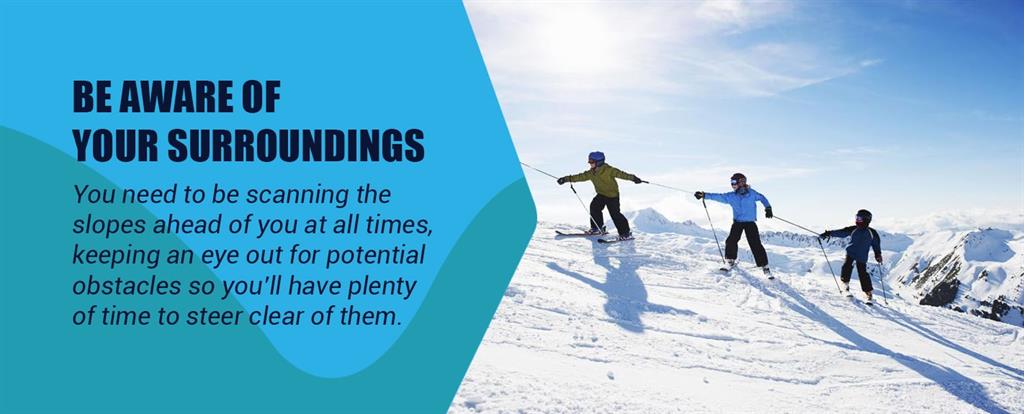
Skiing is not a good opportunity to zone out. When you’re flying down the hill at high speeds, objects and obstacles are going to approach you much faster than you’ll be able to avoid them. You need to be scanning the slopes ahead of you at all times, keeping an eye out for potential obstacles so you’ll have plenty of time to steer clear of them before they become an issue.
Even if you’re standing still or waiting at the top of the hill, you still need to keep alert. Watch out for other skiers who might be headed towards you or anything that might be blocking your path while walking. It would be a shame if you completed all of your ski runs safely only to have an accident while walking back to the car.
9. Keep an Eye on the Weather
Is it safe to ski when it is snowing? Yes - as long as you are properly dressed and have the right gear. If the snow is light and fluffy, it can make for some of the most pleasant skiing conditions you’ll ever experience. If, however, the snow is heavy and wet, or if there’s a strong wind blowing, you'll need to take extra precaution. Die-hard skiers do not let rain deter them , but they are always dressed for it!
10. Stay on the Marked Trail
Whether you’re skiing cross-country or downhill, it’s important to stay on the marked trails and slopes unless you are an expert skier skiing in approved areas. The ski resort has deemed many areas safe for guests, and it’s never wise to test these boundaries. If any areas have been marked with “Off Limits” signs, you should always respect these. Areas like these have been closed off for a reason, and they’re likely unsafe for guests. Keep to the open areas, and you’ll stay safer.
11. Don't Go Beyond Your Limits
We all want to challenge ourselves and keep ourselves on our toes. But there’s a difference between pushing yourself to healthy limits and setting yourself up for disaster. When it comes to skiing, we recommend knowing your limits and not pushing yourself too far beyond them. For example, make sure you’re confident on the beginner hills before you move on to the next level. As much as you may want to jump ahead to the challenge of the advanced hills, we highly recommend that you wait until you are ready. These hills will present challenges you aren’t prepared for yet, and the likelihood of you getting injured will increase.
Keeping within your limits also means paying attention to your body. Whether you’re a beginner or you’ve been skiing for years, everyone has their physical limitations. It may take 20 minutes, or it may take five hours, but eventually, you’ll begin to grow tired, and your body will need to rest before you can head back out onto the slopes. Listen to your body as it tells you it needs a rest. Pushing yourself beyond your physical limits makes you more susceptible to injury.
12. Do Some Warm-ups Before You Begin
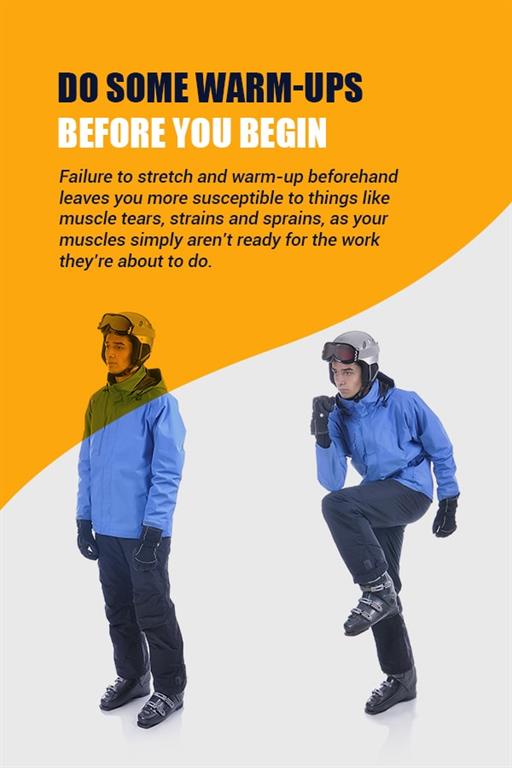
As with any sport, it’s impossible to overemphasize the importance of a warm-up. This helps get your muscles loose, limber and ready for action. This warm-up will likely be individual to each person, as only you can know which muscles you’ll need to stretch and what stretches do this job best. We recommend stretching the legs, arms, back and neck with just a few simple exercises.
Failure to stretch and warm-up beforehand leaves you more susceptible to things like muscle tears, strains and sprains, as your muscles simply aren’t ready for the work they’re about to do. Avoid this by always stretching them out before you begin your exercise.
13. Drink Plenty of Water
Dehydration may not be the number one concern on your mind as you think of common skiing injuries and how to avoid them, but it’s a risk nonetheless. Any time you’re engaged in strenuous activity for long periods of time, it’s critical that you keep hydrated. This water lets your muscles and your brain keep working, allowing you to keep performing to the best of your ability. If you become dehydrated, you won't be able to ski well, and you could even become ill. Keep some water or a sports drink with you on the hill and replenish your fluids regularly throughout the day.
Shop Ski Gear and Clothing Today
With tips like these under your belt, you’re ready to head out and start tackling your ski resort of choice. But first, take a minute to make sure you’ve got all the gear you need to be successful. If you find you’re missing any of the essential pieces of ski clothing or equipment, from skis and poles to base layer, boots or jackets, come visit us at Buckman’s Ski and Snowboard Shops. We’re proud to stock the very finest names in winter sports gear and clothing, and we want to help prepare you for the best skiing experience possible.
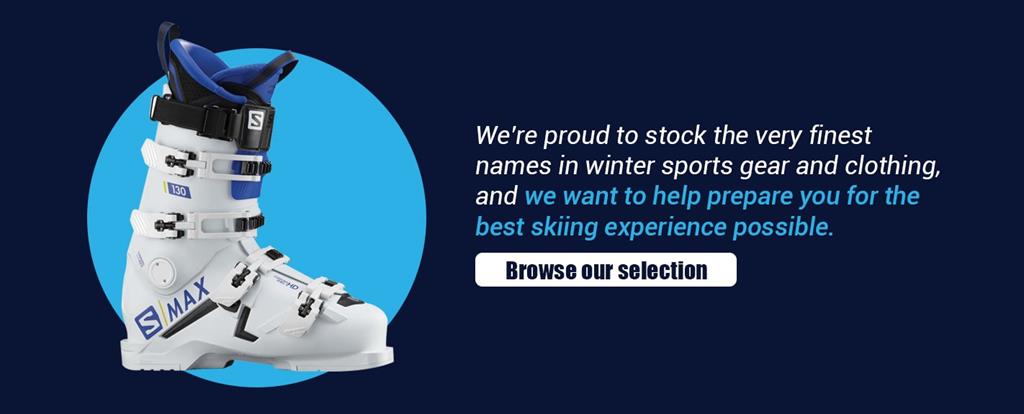
Browse our full selection today to get started.
Categories:
Ski equipment
|
Snowboard Equipment
Tagged: ski, snowboard, ski and snowboard equipment